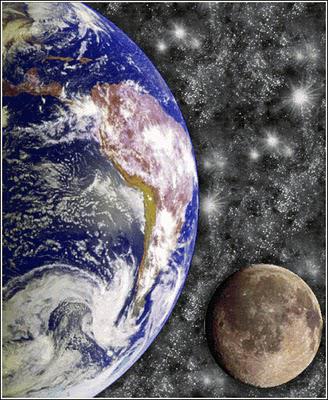The diameter of the Moon is 3476 km, and mass 7.35 x 1022 kg or 1 / 81 Earth masses. Surface gravity is six times weaker than gravity on Earth. The period of rotation of the Moon around its axis is 27.3 days, exactly as the period of rotation around the Earth, so from Earth is visible always the same hemisphere.
The lunar landscape is completely different from the Earth's. Instead of being dominated by continents and oceans, the Moon's face is everywhere cratered - circular pits or basins, which have created impacts inter-planetary debris over the history of the solar system. The craters bear silent witness of the time billions of years ago - when the collisions with these large bodies were much more common. The Moon has no air or water to erode the crater and still bears scars of billions of years old.

The soil of the great basins on the Moon that is facing the Earth is covered by vast expanses of dark-colored rock. These great plains are relatively smooth and have fewer large craters than other areas of the Moon. They are called plains, seas, or more commonly, as Galileo and other early researchers thought that they represent a smooth area where there is water. Today we know that it is not water, but already solidified lava that flowed through the lower regions of the moon after being kicked off a large impact basins that were formed.
Age of lunar soil was determined by radioactive method and is 4.6 to 3.5 billion years ago. The material from which the Moon formed had a lower density than the material from which Earth emerged.
There are many theories about the origin of the Moon, and currently most widely accepted claims that arose from the collision of a Mars-sized planetoid and the young Earth. Remains of other planetoid stay in orbit around the Earth along with parts of its bark. Over time, this ring of material gathered and formed the Moon.
The largest sea, Ocean of Storms (lat. Procelarum Oceanus), is large, such as the Mediterranean Sea. All others have a circular shape, the largest is Sea of Rain with a diameter larger than 1000 km. Rimmed by mountains called the mountain ranges on Earth: Montes Alpes, Montes Caucasus, Montes Apenninus, Montes Carpatus.
